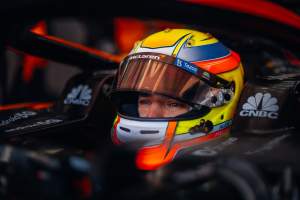Up Next

McLaren went to Spa hoping for a wet weekend and if it had been it was well prepared. Unfortunately, it wasn’t and it suffered the consequences of running too high a rear wing for the dry conditions.
The team said at the time it didn’t have an efficient wing level for those conditions on that circuit, so has worked overtime to come up with a more efficient package.
It’s nice to see some new ideas appearing from time to time and this detail on the new rear wing that McLaren introduced in Zandvoort is just that. It ran on both cars on Friday but, because of the wet conditions and Oscar Piastri’s FP2 crash, McLaren has decided to run the old specification for the rest of the weekend.
This area at the outer corner of the rear wing (red ellipse) normally sets up very strong vortices. These can be seen when the cars are running in damp conditions.
This happens because it is the meeting point of three fairly different air pressures – low pressure under the wing, high pressure on top of it and ambient (ish) on the outside of the endplate. These vortices are more dramatic the higher the downforce level and with that comes more drag.
Drag-wise, these vortices are like a parachute being pulled along behind the car, so minimising them is one way to get a drag reduction on the overall car. It will affect the downforce level the rear wing can produce because you are allowing those three different pressures to meet up earlier.
The under-surface flow is highlighted with the blue arrows and the upper-surface flow highlighted with the green arrows. As the flow comes around that outer corner, it is more sympathetic to the normal flow of the car passing through the air.

The Gurney flap (magenta arrow) fitted across the span of the wing trips the flow at the trailing edge of the wing. This actually is reasonably efficient and does improve the braking stability more than a simple increase in wing angle.
McLaren has replaced some of that lost downforce by increasing the width (yellow arrow) of the lowest part of the wing, which proves to me that the actual efficiency of the wing profile is better than the effect those vortices have on the outer ends of the wing.

This is what Andrea Stella had to say on Saturday about these modifications and how McLaren is getting prepared for Monza.
“As part of our redesign of the car that we started after a few races, we are now at the stage where we are starting to bring some rear wings,” said Stella. “So yesterday [Friday] we had a new rear wing, which is a slightly lower drag, lower downforce than the maximum downforce wing that we had before and that we used in Hungary.
“The wing we had yesterday is suitable for this track in dry conditions, not necessarily in wet conditions. So we will see today what wing we are going to use for the remainder of the weekend. But the good news is that the part that we brought trackside correlates well with expectation. So we now have a wing that we can use for some other races coming like Singapore, Japan, Qatar, and so on.
“In terms of Monza, we are making some adjustments. After Spa, we needed to urgently activate some actions to find some top speed because Monza is going to set some challenges similar to what we had in Spa. So there will be some modifications in Monza which hopefully will allow us not only to be quick in terms of laptime, but also to be raceable in terms of top speed.”
I’ll be very interested to see what McLaren will come up with for Monza. That really is a low-downforce, low-drag track.





